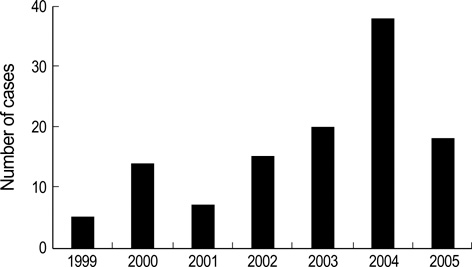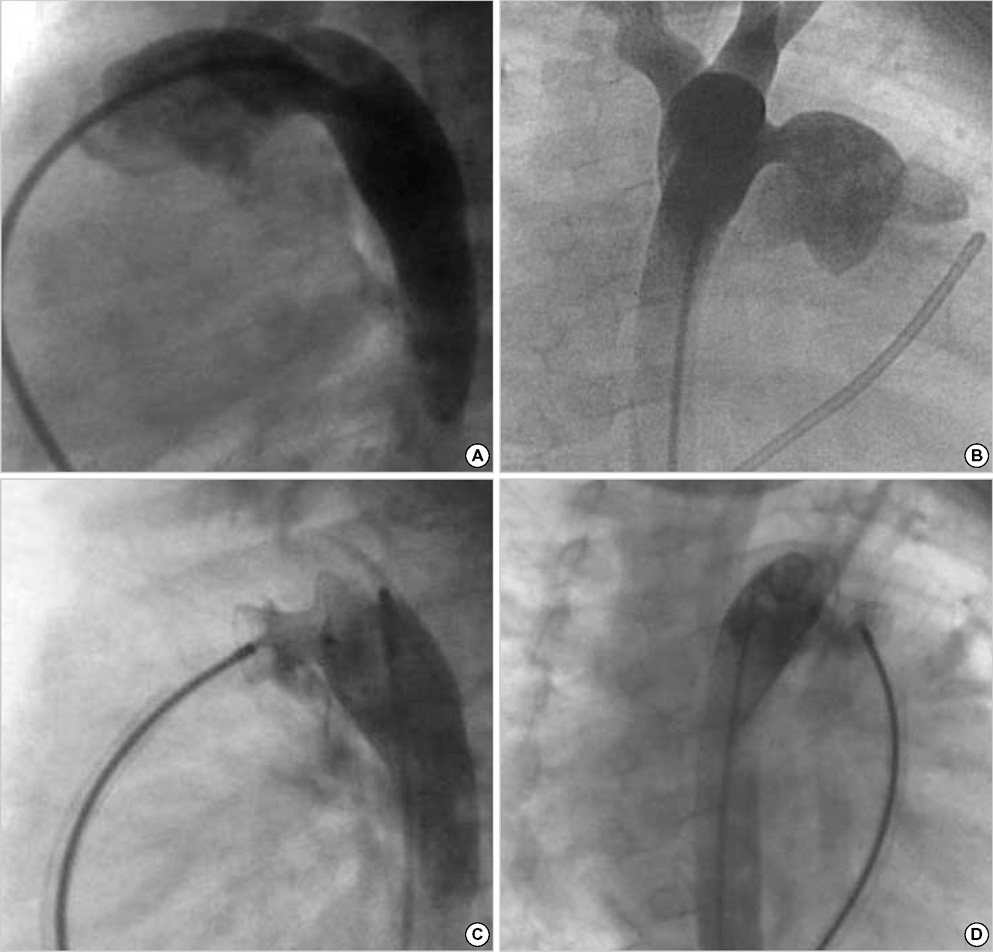J Korean Med Sci.
2007 Jun;22(3):484-490. 10.3346/jkms.2007.22.3.484.
Complications after Transcatheter Closure of Patent Ductus Arteriosus
- Affiliations
-
- 1Department of Pediatrics, Korea University Hospital, 516 Gojan 1-dong, Danwon-gu, Ansan, Korea. jgynhg@dreamwiz.com
- 2Department of Pediatrics, Sejong Hospital, Bucheon, Korea.
- KMID: 1778358
- DOI: http://doi.org/10.3346/jkms.2007.22.3.484
Abstract
- To evaluate the short- and mid-term results and complications ensuing the transcatheter closure of patent ductus arteriosus (PDA). Between October 1999 and December 2005, 117 patients (34 males and 83 females) underwent attempted percutaneous closure of PDA with a minimum diameter of more than 3 mm. Follow-up evaluations were conducted at 1 day and 1, 3, 6, 12 months after the performance of the transcatheter closure. The median age of patients at catheterization was 11 yr (range, 0.6 to 68 yr), median weight was 30 kg (range, 6 to 74 kg), and the median diameter of PDA was 4 mm (range, 3 to 8 mm). This procedure was conducted successfully in 114 patients (97.4%), using different devices. Major complications were detected in 4 patients (3.4%); significant hemolysis (2), infective endocarditis (1), failed procedure due to embolization (1). Minor complications occurred in 6 patients (5.1%); mild narrowing of the descending aorta (2) and mild encroachment on the origin of the left pulmonary artery (4). Although the transcatheter closure of PDA may be considered to be effective, several complications, including hemolysis, embolization, infective endocarditis, and the narrowing of adjacent vessels may occur in certain cases.
MeSH Terms
Figure
Reference
-
1. Portsmann W, Wierny L, Warnke H, Gerstberger G, Romaniuk PA. Catheter closure of patent ductus arteriosus: 62 cases treated without thoracotomy. Radiol Clin North Am. 1971. 9:203–218.2. Uzun O, Hancock S, Parsons JM, Dickinson DF, Gibbs JL. Transcatheter occlusion of the arterial duct with Cook detachable coils: early experience. Heart. 1996. 76:269–273.
Article3. Tometzki AJ, Arnold R, Peart I, Sreeram N, Abdulhamed JM, Godman MJ, Patel RG, Kitchiner DJ, Bu'Lock FA, Walsh KP. Transcatheter occlusion of the patent ductus arteriosus with Cook detachable coils. Heart. 1996. 76:531–535.
Article4. Celiker A, Quershi SA, Bilgic A, Carminati M, Kirk S, Rosenthal E, Alehan D, Giusti S, Baker EJ, Tynan M. Transcatheter closure of patent arterial ducts using controlled release coils. Eur Heart J. 1997. 18:450–454.5. Pass RH, Hijazi Z, Hsu DT, Lewis V, Hellenbrand WE. Multicenter USA Amplatzer patent ductus arteriosus occlusion device trial: initial and one-year results. J Am Coll Cardiol. 2004. 44:513–519.
Article6. Thanopoulos BD, Hakim FA, Hiari A, Goussous Y, Basta E, Zarayelyan AA, Tsaousis GS. Further experience with transcatheter closure of the patent ductus arteriosus using the Amplatzer duct occluder. J Am Coll Cardiol. 2000. 35:1016–1021.
Article7. Faella HJ, Hijazi ZM. Closure of the patent ductus arteriosus with the amplatzer PDA device: immediate results of the international clinical trial. Catheter Cardiovasc Interv. 2000. 51:50–54.
Article8. Al-Ata J, Arfi AM, Hussain A, Kouatli AA, Jalal MO. The efficacy and safety of the Amplatzer ductal occluder in young children and infants. Cardiol Young. 2005. 15:279–285.
Article9. Krichenko A, Benson LN, Burrows P, Moes CA, McLaughlin P, Freedom RM. Angiographic classification of the isolated, persistently patent ductus arteriosus and implications for percutaneous catheter occlusion. Am J Cardiol. 1989. 63:877–880.
Article10. Rashkind WJ, Mullins CE, Hellenbrand WE, Tait MA. Nonsurgical closure of patent ductus arteriosus: clinical application of the Rashkind PDA Occluder System. Circulation. 1987. 75:583–592.
Article11. Rao PS, Sideris EB, Haddad J, Rey C, Hausdorf G, Wilson AD, Smith PA, Chopra PS. Transcatheter occlusion of patent ductus arteriosus with adjustable buttoned device. Initial clinical experience. Circulation. 1993. 88:1119–1126.
Article12. Moore JW, George L, Kirkpatrick SE, Mathewson JW, Spicer RL, Uzark K, Rothman A, Cambier PA, Slack MC, Kirby WC. Percutaneous closure of the small patent ductus arteriosus using occluding spring coils. J Am Coll Cardiol. 1994. 23:759–765.
Article13. Bilkis AA, Alwi M, Hasri S, Haifa AL, Geetha K, Rehman MA, Hasanah I. The Amplatzer duct occluder: experience in 209 patients. J Am Coll Cardiol. 2001. 37:258–261.
Article14. Kim Y, Chio JY, Lee JK, Sul JH, Lee SK, Park YH, Cho BK. Midterm result of the transcatheter occlusion of patent ductus arteriosus with duct-occlud device and procedure-related problems. Korean J Pediatr. 2004. 47:36–43.15. Masura J, Walsh KP, Thanopoulous B, Chan C, Bass J, Goussous Y, Gavora P, Hijazi ZM. Catheter closure of moderate- to large-sized patent ductus arteriosus using the new Amplatzer duct occluder: immediate and short-term results. J Am Coll Cardiol. 1998. 31:878–882.
Article16. Ali Khan MA, al Yousef S, Mullins CE, Sawyer W. Experience with 205 procedures of transcatheter closure of ductus arteriosus in 182 patients, with special reference to residual shunts and long-term follow-up. J Thorac Cardiovasc Surg. 1992. 104:1721–1727.
Article17. Uzun O, Veldtman GR, Dickinson DF, Parsons JM, Blackburn ME, Gibbs JL. Haemolysis following implantation of duct occlusion coils. Heart. 1999. 81:160–161.
Article18. Verin VE, Saveliev SV, Kolody SM, Prokubovski VI. Results of transcatheter closure of the patent ductus arteriosus with the Botallooccluder. J Am Coll Cardiol. 1993. 22:1509–1514.
Article19. Hijazi ZM, Geggel RL. Transcatheter closure of large patent ductus arteriosus (>4 mm) with multiple Gianturco coils: immediate and mid-term results. Heart. 1996. 76:536–540.20. Galal O, de Moor M, Fadley F, Quershi S, Naffa S, Oufi S, Suhl M, Abbag F, Schmaltz AA. Problems encountered during introduction of Gianturco coils for transcatheter occlusion of the patent arterial duct. Eur Heart J. 1997. 18:625–630.
Article21. Hijazi ZM. Catheter closure of ductus arteriosus in adolescents and adults: what to use? Catheter Cardiovasc Interv. 2002. 55:519–520.
Article22. Vijayalakshmi IB, Chitra N, Rajasri R, Prabhudeva AN. Amplatzer angled duct occluder for closure of patent ductus arteriosus larger than the aorta in an infant. Pediatr Cardiol. 2005. 26:480–483.
Article23. Ewert P, Kretschmar O, Nuernberg JH, Nagdyman N, Lange PE. First closure of a large patent ductus arteriosus in an infant with an angulated nitinol plug. Catheter Cardiovasc Interv. 2002. 57:88–91.
Article24. Fukahara K, Minami K, Reiss N, Fassbender D, Koerfer R. Systemic allergic reaction to the percutaneous patent foramen ovale occluder. J Thorac Cardiovasc Surg. 2003. 125:213–214.
Article25. Lai DW, Saver JL, Araujo JA, Reidl M, Tobis J. Pericarditis associated with nickel hypersensitivity to the Amplatzer occluder device: a case report. Catheter Cardiovasc Interv. 2005. 66:424–426.
Article
- Full Text Links
- Actions
-
Cited
- CITED
-
- Close
- Share
- Similar articles
-
- Three Cases of Hemolysis After Transcatheter Closure of A Patent Ductus Arteriosus
- Nonsurgical closure of patent ductus arteriosus with the rashkind PDA occluder system
- Transcatheter Closure of a Residual Patent Ductus Arteriosus After Surgical Ligation in Children
- Use of an Amplatzer Vascular Plug to occlude a tubular type of patent ductus arteriosus
- PDA Clipping by Using 2mm Thoracoscope






